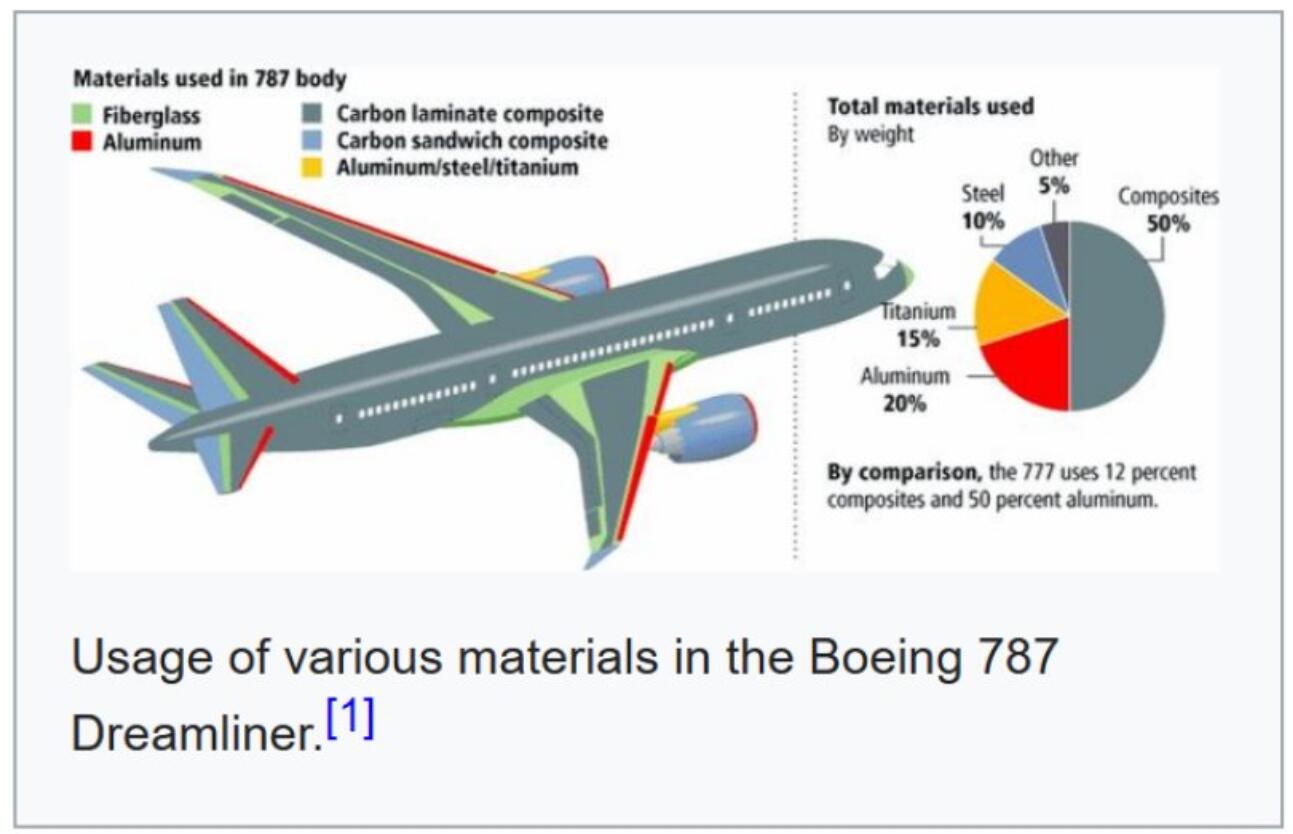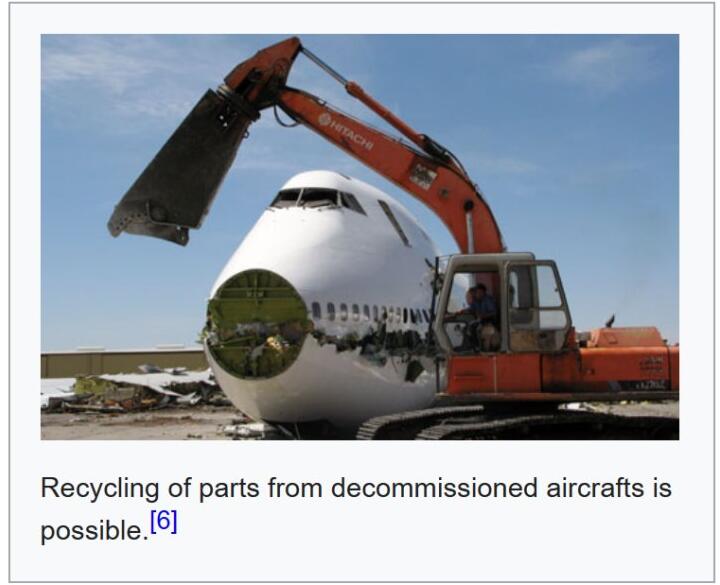Composite materials can be formed into various shapes. If necessary, the fibers can be tightly wrapped to increase strength. A useful feature of composite materials is that they can be layered, and the fibers in each layer move in different directions. This allows engineers to design structures with unique performance. For example, a structure can be designed to bend in one direction rather than in the other.

Usage of various materials of Boeing 787 Dreamliner
Synthesis of composite materials
In the basic composite materials, one material acts as the support matrix, while the other material is based on this and strengthens the whole material. The formation of this material is an expensive and complex process. In essence, the substrate is spread in the mold under high temperature and pressure. Then, pour the epoxy resin or resin onto the base material, and when the composite material cools, it will form a solid material. The composite can also be produced by embedding the fibers of the secondary material into the matrix.
Composite materials have good tensile strength and compression resistance, and are suitable for aircraft parts manufacturing. The tensile strength of this material comes from its fiber properties. When the tensile force is applied, the fibers in the composite are aligned with the direction of the applied force, thus obtaining the tensile strength. Its good compressive performance can be attributed to the adhesion and stiffness of the matrix system. The function of the resin is to keep the fiber straight and prevent it from bending.
Aerospace and composite materials
Composite materials are important to the aviation industry because they have the same structural strength as metal alloys, but they are lighter in weight. This will improve the fuel efficiency and performance of the aircraft.
1. Role of composite materials in aviation industry
Glass fiber is the most common composite material, which is composed of glass fiber embedded in resin matrix. Glass fiber was first widely used in ships and automobiles in the 1950s. Glass fiber was first used in the Boeing 707 airliner in the 1950s, when it accounted for only 2% of the entire structure. Each generation of new aircraft manufactured by Boeing has increased the proportion of composite materials used; The highest utilization rate of composite materials is 50% of the 787 Dreamliner.
The Boeing 787 Dreamliner will be the first commercial aircraft whose main structural components are made of composite materials rather than aluminum alloys. This aircraft will shift from the old glass fiber composite materials to more advanced carbon laminated and carbon sandwich composite materials. The wing box of the Dreamliner had encountered problems because the composite material used to manufacture the component was not rigid enough, which led to the delay of the aircraft's initial delivery date. In order to solve these problems, Boeing is strengthening the wing box by adding new supports to the built wing box, and modifying the wing box that has not been built.
2. Testing of composite materials
Due to the complexity of materials, it is difficult to accurately simulate the performance of composite components by computer simulation. Composite materials are usually stacked layer by layer to increase strength, but this complicates the test stage before manufacturing. Because the directions of these layers are different, it is difficult to predict their performance during testing.
Mechanical stress test can also be performed on parts. These tests start with the small model, and then proceed to the larger part of the structure, and finally to the whole structure. These structural components are put into the hydraulic press, and through bending and twisting to simulate the pressure far beyond the worst expected conditions in real flight.
3. Use factors of composite materials
Weight reduction is the greatest advantage of composite materials, and also one of the key factors to determine their choice. Other advantages include its high corrosion resistance and fatigue damage resistance. These factors have played a certain role in reducing the operating cost of the aircraft and further improving its efficiency in the long run. The advantage of composite materials is that they can be made into almost any shape by molding process, but this exacerbates the already difficult modeling problem.
One of the main disadvantages of using composite materials is that they are relatively new materials, so the cost is high. High costs are also attributed to labor-intensive and often complex manufacturing processes. Composite materials are difficult to detect defects, and some of them absorb moisture.
In contrast, although aluminum is heavier, it is easy to manufacture and repair. It can be dented or punctured, but it remains together. This is not the case with composite materials; If they are damaged, they need to be repaired immediately, which is difficult and expensive.
4. Save fuel and reduce weight
Fuel consumption depends on several variables, including: aircraft dry weight, payload weight, aircraft age, fuel quality, airspeed, weather, etc. The weight of aircraft components made of composite materials has been reduced by about 20%, such as the 787 Dreamliner.
5. Environmental impact
The shift to green engineering is more obvious. Our environment is receiving more and more consideration and attention in today's society. The same is true for composite material manufacturing.
As mentioned earlier, composite materials have lighter weight and similar strength values to heavier materials. When lighter composite materials are transported or used in transportation applications, the environmental load is lower than that of heavier alternatives. Composite materials are also more corrosion resistant than metal matrix materials, which means that the service life of parts is longer. From the perspective of environment, these factors combine to make composite materials a good substitute.
The traditional composite materials are made of petroleum fiber and resin, which are essentially non-biodegradable, which creates a serious problem, because once the life cycle of the composite materials ends, most of the composite materials will be thrown into the landfill. Biodegradable composite materials made of natural fiber are undergoing important research. The discovery of biodegradable composite materials can be easily manufactured on a large scale, And it has similar properties to traditional composite materials, which will bring revolutionary changes to several industries including aviation industry.
Another option to help environmental protection is to recycle the old parts of retired aircraft. The "de-engineering" of aircraft is a complex and expensive process, but due to the high cost of purchasing first-hand parts, it may save money for the company.

It will be possible to recycle the components of retired aircraft
Future composite materials
——Ceramic matrix composites
NASA is vigorously developing lightweight high-temperature composites for aircraft components. According to the preliminary calculation, the turbine inlet temperature of a concept engine is expected to be as high as 1650 ° C. In order to make the material able to withstand such temperature, ceramic matrix composites (cmc) are required. The use of cmc in advanced engines can also increase the temperature of the engine during operation, thus increasing the output. Although cmc is a promising structural material, its application is limited due to the lack of suitable reinforcement materials, processing difficulties, life and cost.
——Spider silk fiber
Spider silk is another promising composite material. Spider silk has high ductility, which can stretch to 140% of the normal length and maintain its strength at a low temperature of minus 40 degrees Celsius. These characteristics make spider silk an ideal fiber material for producing tough composite materials, and can maintain its strength even at abnormal temperatures. The ductile composite material will benefit the parts of the aircraft and will be subject to variable stress, such as the connection between the wing and the main body. The increased strength, toughness and ductility of this composite material will allow greater stress to be applied to components or connections before catastrophic failure occurs. Another advantage of composite materials based on synthetic spider silk is that their fibers are biodegradable.
In the laboratory, people have tried to replicate spider silk many times, but they have not succeeded, but they have not yet achieved perfect re-synthesis.
Conclusion
Composite materials have advantages over traditional metal materials due to their high strength to weight ratio; Although, it is expensive to manufacture composite materials at present. This relatively new material will not completely replace the traditional metal alloy until the introduction of technology to reduce the initial implementation cost and solve the current problem of non-biodegradable composite materials.
The source of the article is China Composite Materials Industry Association, website https://www.aibangfrp.com/a/8416